
Heating greenhouses
Heating is used to provide optimal temperatures for crop growth and for management of the humidity in the greenhouse. Heating may be needed throughout the year, not just in winter. Heat should ideally be applied as low as possible in the greenhouse (with the exception of "grow pipes") and distributing heat evenly is essential for optimal crop production.
There are essentially two methods of heating - hot air and hot water. Hydronic heating refers to the use of a boiler to heat water which is then piped through the greenhouse. The pipes, located around the walls of the structure and/or between plant rows, radiate heat. The major costs are in the boiler and piping. A centralised hydronic heating system is generally a more efficient form of heating in greenhouses greater than 1000m2 and especially where there are several separate greenhouses. When hot water heating is used, the boilers may be situated away from the greenhouse. This flexibility provides the opportunity to locate potentially noisy boilers away from farm boundaries to minimise disturbance to neighbours.
Heated air can also be used to maintain temperatures in a greenhouse. Hot air may be directly generated in the greenhouse or the internal air can be warmed through heat exchange with an external heat source. Where combustion occurs at the source of the heat, such as in a gas fired heater, locating the heater outside the greenhouse and using a heat exchange pad to warm the internal air is recommended. This is because the combustion process can result in ethylene production and also water vapour. Ethylene can cause leaf drop and premature ripening of fruit. Increased moisture levels in the air may result in excessive humidity and condensation problems.
Gas remains the primary source of energy for greenhouse heating in Australia. Oil, diesel and coal are also used. Natural gas is lower cost and clean burning. It does not require on-farm storage tanks and is typically low maintenance. Unfortunately, natural gas is not available in all areas. Bottled gas (LPG) is similar to natural gas but more expensive. Costs can be volatile and storage tanks are needed.
Oil and diesel are more expensive than natural gas and because these fuels do not burn as cleanly, more boiler maintenance is needed. On-farm storage is also required.
Coal is relatively low cost if it is locally available. It is more polluting than other fuel sources. Large storage areas are needed on farm as well as loading equipment. As coal does not burn as cleanly, significant boiler maintenance is needed.
Greenhouse heating requirements
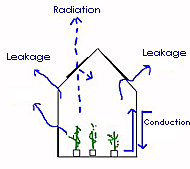
Three ways heat is lost from the greenhouse
1. Conduction – direct movement through structural materials
2. Leakage – hot air escaping through gaps and doorways
3. Radiation – radiate energy moving directly through covering materials
The main basis for heating in a greenhouse is the replacement of lost heat. Heat can be lost through conduction, leakage and radiation. Most heat is lost through conduction, where heat energy is transferred directly through covering materials and the structure to the outside atmosphere.
Leakage of air accounts for the next greatest amount of lost heat. In a well constructed and maintained structure as much as 10% of heat loss can still be due to leakage. In greenhouses with poorly fitting doors, partially opened vents, other gaps or broken covering materials, significantly more heat can be lost this way. The heat lost through radiation depends on the covering material. It is often ignored. Glass will not allow much heat to be lost through radiation, though polyethylene film is practically transparent to thermal radiation.
Working out how much heating is needed
Heat losses are worked out for the coldest expected night temperatures. This then gives the maximum heating capacity needed. Heater capacity is calculated from the heat load (Q) of the greenhouse and the heater efficiency.
Calculating the total heat load (QT)
The total heat load is the sum of the amount of heat loss through all three different processes – conduction (QC) + Leakage (QL) + Radiation (QR);
QT = QC + QL + QR
Radiation is the third way in which heat can be lost from the greenhouse. The heat load through radiation (QR) depends on the covering material. Glass does not permit much heat to escape through radiation, but basic polythene covering materials can. There are, however, a number of plastic films are on the market today that restrict thermal radiation. These are known as thermic films.
The loss due to radiation is generally ignored, so the total heat load is;
QT = QC + QL
Heat load due to conduction (QC)
Conduction – the transfer of heat through the structural materials – is the main way that heat is lost. Different materials have a different conduction values. These are referred to as ‘U’ values or heat transfer values. They are measured in Watts per square metre per degree Kelvin or you may find them in Btu per hour per square foot per degree Fahrenheit.
You also need to know the surface area of the greenhouse and the difference between the temperature set point for your crop and the coldest outside temperature.
Heat transfer values
| Covering material | U value | |
|---|---|---|
| Watts / m2 ° | Btu / hr sq.ft °F | |
| Single polythene plastic film | 7.5 – 8.5 | 1.2 – 1.5 |
| Double polythene plastic film | 4.0 – 5.0 | 0.7 – 0.9 |
| Polycarbonate | 6.8 | 1.2 |
| Polycarbonate double walled | 3.5 | 0.6 |
| Glass 3 mm | 7.0 – 8.0 | 1.2 – 1.4 |
| Glass 6 mm | 6.5 | 1.15 |
| Thermal screen | 2.8 | 0.5 |
Surface area (SA) of greenhouse
The amount of heat that can be transferred out of the greenhouse is dependent on the surface area of the structure. A large surface area can lose more heat than a smaller surface area over the same period of time. The surface area of the greenhouse is referred to as 'SA' and is measured in square metres. The area includes the roof and all the walls of the greenhouse.
Gable type greenhouse
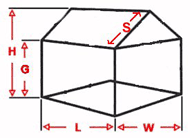
For a gable type greenhouse, you need to measure the total height to the roof peak (H), the height of the gutter or eave (G), the width (W), the length (L) and the width of the roof slope (S).
The surface area is sum of the following:
- Area of side walls = 2 x (L x G)
- Area of sloping roof = 2 x (L x S)
- Area of end walls = 2 x [(G x W) + (0.5 x (H - G)) x W]
- Total surface area = Area of side walls + area of roof + area of end walls
Note that a multispan greenhouse only has 2 side walls, but every bay has roof areas and end walls.
Tunnel house
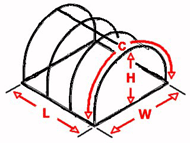
For a tunnel house, you need to measure the height (H), the width (W), the length (L) and the length of the curved frame (C).
The surface area is sum of the following:
- Area of curved roof and walls = L x C
- Area of end walls = 2 x π x (h x w)
- where π = 3.14
Total surface area = Area of curved roof and walls + area of end walls
Straight walled curved roof
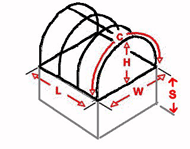
For a straight walled curved roof greenhouse, you need to measure the height of the curved section (H), the width (W), the length (L) and the length of the curved frame (C). You also need the height of the vertical section of the side (S).
The surface area is the sum of the following:
- Area of curved roof and walls = L x C
- Area of curved part of end walls = 2 x π x (h x w) where π = 3.14
- Area of rectangular side walls = 2 x L x S
- Area of rectangular part of end walls = 2 x W x S
- Total surface area = Area of curved roof and walls + area of curved part of end walls + area of rectangular side walls + area of rectangular part of end walls
Note that a multispan greenhouse only has 2 side walls, but every bay has roof areas and end walls.
Temperature difference (Δ)
The temperature difference (Δ), called "delta T", is the difference between the minimum required temperature in the greenhouse and the lowest outside temperature. The required temperature in the greenhouse is the set point that you want to achieve. This may be a compromise temperature to reduce heating costs. For example, while you may want a minimum night temperature of 19°C, to reduce your heating costs, you might decide to use a set point of 17°C instead.
If the lowest outside temperature is 1°C and your set point is 17°C, the ΔT is 16 degrees.
Calculating heat load due conduction
The heat load due to conduction (QC) of your greenhouse equals the heat loss (U) multiplied by surface area (SA) multiplied by the temperature difference, divided by 1000. This will give you a heat load in kilowatts (kW):
QC = (U x SA x ΔT) / 1000
Additional accuracy in calculating the heat load can be achieved by including;
a) the effect of wind
Wind increases the removal of heat from the outside of the greenhouse so more heat can be transferred faster. If you are in a particularly windy area, especially during winter, it is a good idea to include it. The stronger the wind is, the greater the heat loss. A wind factor (W) is used in the heat loss calculation.
QC = (U x SA x ΔT x W) / 1000
b) the amount of heat loss through the floor
The greenhouse floor is another surface where some heat can be lost. To include the loss of heat through the floor, you will need a U value for the floor (eg poured concrete is about 1.1, black plastic is about 2.7) and the surface area of the floor.
Heat load due to leakage (QL)
Air leakage is usually the second biggest source of heat loss from a greenhouse. To include the heat load due to air leakage (QL), you will need to know the air volume of the greenhouse in cubic metres (V), the number of air changes occurring (E) and the wind factor (W) and the difference between your temperature set point and the outside minimum temperatures (ΔT).Leakage (QL) = 0.373 x ΔT x V x E x W
For the wind factor (W), refer to the table below.
| Wind Speed (km/hr) | Wind factor (W) |
|---|---|
| < 25 | 1.0 |
| 30 | 1.025 |
| 35 | 1.05 |
| 40 | 1.075 |
Calculating greenhouse air volume
To calculate greenhouse air volume (V), imagine the structure as different shapes (rectangular, triangular or half cylindrical) and use the following formulae.
Volume of a rectangular section Formula: Volume = Length x Width x Height | 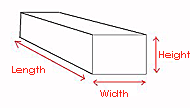 |
Volume of a gable section Formula: Volume = 0.5 x Length x Width x Height |  |
Volume of a tunnel section Formula: Volume = Length x 6.28 x Width x Height |  |
If the greenhouse is made up of more than one shape, work out the volume for each and add them together. All dimensions should be in metres to give you a volume in cubic metres.
For the number of air changes (E), use the following table.
| Greenhouse design | Air exchanges (E) (Leakage) |
|---|---|
| Single polythene film and metal frame | 1.0 |
| Double polythene film and metal frame | 0.7 |
| Single layer of glass and metal frame | 1.08 |
Heater capacity
Once you know what the maximum heat load of your greenhouse is, you can work out what capacity of heating system that you need. This is dependent on how efficient the heater is. In general, using bottled or natural gas, the heating efficiency is about 80%.Heater capacity = Heat load of your greenhouse (Q) / Heater efficiency
Reducing heating requirements
There are a number of strategies that can be used to reduce heating costs.
- Use a greenhouse design that minimises surface area relative to production area, for example, a gutter connected multispan greenhouse has a smaller surface area than a number of separate greenhouses of the same total production area.
- Use cladding materials that have a low U value, for example, a double skin polythene clad greenhouse loses less heat than a single skin polythene covered greenhouse.
- Use thermal screens which have a lower U value than the cladding material.
- Close air leaks and repair any damage in the cladding materials. Make sure doors and vents close tightly.
- Use windbreaks to reduce the speed of wind passing over the greenhouse.
- Use the most efficient heater possible.
- Use an automated control system.
- Use cooler set points when possible, for example when controlling to a 24 hour average temperature regime, increase the day temperature and lower the night temperature.

